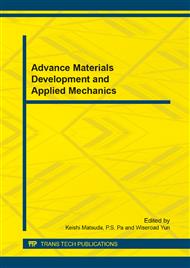p.411
p.417
p.421
p.425
p.431
p.435
p.439
p.444
p.450
Damage Identification of the Blade Based on Distributed Fiber Bragg Grating Sensors
Abstract:
As the foundation work of the damage identification for the blade, the purpose of this paper is to determine which parts of the blade are more sensitive to the damage and how serious damage could affect the dynamic response of the blade structure. Several damage states are simulated using the magnets, and then the distributed fiber Bragg grating sensor system is used to measure the dynamic strain response of the blade under the random excitation. The dynamic strain time domain signal is first analyzed, and then the different damage states are identified. In order to eliminate the adverse affect of the environmental and operational variations, the Hilbert-Huang Transform method is used to extract the damage-induced signal component. Lastly the damage index based on the autoregressive model and Mahalanobis distance method is constructed to detect damage. Some conclusions are obtained from the experimental results.
Info:
Periodical:
Pages:
431-434
Citation:
Online since:
July 2014
Authors:
Price:
Сopyright:
© 2014 Trans Tech Publications Ltd. All Rights Reserved
Share:
Citation:


